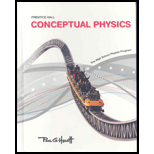
A satellite can orbit at 5 km above the moon, but not at 5 km above Earth. Why?
To Explain: A satellite can orbit around 5 km above the moon but not 5 km above the earth.
Explanation of Solution
Introduction:
Satellite is the body in space which can revolve around the planet. Satellite may be natural or artificial. Around 2218 artificial satellite are orbiting around earth. Moon is the only natural satellite which moves around the earth.The satellite remains in its orbit because of the gravitational force due to planetwhich acts on it.
Momentum of rocket gained by the satellite keeps satellite in motion. When satellite moves over thousands of miles, force due to gravity still acts on it. When satellite moves in an orbit, gravity pulls it towards its center. The momentum of the satellite keepsit in motion. So, when satellite move in stationary orbit around the planet, the force due to gravity balances the momentum of the satellite. If the momentum of the satellite encounters the force due to gravity, satellite follow the straight-line path.
Orbital velocity of the satellite depends upon the distance of the satellite from the planet. Less be the distance; more be the velocity and vice-versa. The value of the acceleration to gravity decides the distance over which satellite can safely orbit. The acceleration due to gravity for earth and moon is
Conclusion:
Therefore, due to earth’s strong gravitational pull as well as presence atmosphere around the earth, satellite cannot orbit around earth 5 km above.
Chapter 14 Solutions
Conceptual Physics: The High School Physics Program
Additional Science Textbook Solutions
Conceptual Physical Science (6th Edition)
Life in the Universe (4th Edition)
College Physics: A Strategic Approach (4th Edition)
Conceptual Integrated Science
Physics (5th Edition)
An Introduction to Thermal Physics
 College PhysicsPhysicsISBN:9781305952300Author:Raymond A. Serway, Chris VuillePublisher:Cengage Learning
College PhysicsPhysicsISBN:9781305952300Author:Raymond A. Serway, Chris VuillePublisher:Cengage Learning University Physics (14th Edition)PhysicsISBN:9780133969290Author:Hugh D. Young, Roger A. FreedmanPublisher:PEARSON
University Physics (14th Edition)PhysicsISBN:9780133969290Author:Hugh D. Young, Roger A. FreedmanPublisher:PEARSON Introduction To Quantum MechanicsPhysicsISBN:9781107189638Author:Griffiths, David J., Schroeter, Darrell F.Publisher:Cambridge University Press
Introduction To Quantum MechanicsPhysicsISBN:9781107189638Author:Griffiths, David J., Schroeter, Darrell F.Publisher:Cambridge University Press Physics for Scientists and EngineersPhysicsISBN:9781337553278Author:Raymond A. Serway, John W. JewettPublisher:Cengage Learning
Physics for Scientists and EngineersPhysicsISBN:9781337553278Author:Raymond A. Serway, John W. JewettPublisher:Cengage Learning Lecture- Tutorials for Introductory AstronomyPhysicsISBN:9780321820464Author:Edward E. Prather, Tim P. Slater, Jeff P. Adams, Gina BrissendenPublisher:Addison-Wesley
Lecture- Tutorials for Introductory AstronomyPhysicsISBN:9780321820464Author:Edward E. Prather, Tim P. Slater, Jeff P. Adams, Gina BrissendenPublisher:Addison-Wesley College Physics: A Strategic Approach (4th Editio...PhysicsISBN:9780134609034Author:Randall D. Knight (Professor Emeritus), Brian Jones, Stuart FieldPublisher:PEARSON
College Physics: A Strategic Approach (4th Editio...PhysicsISBN:9780134609034Author:Randall D. Knight (Professor Emeritus), Brian Jones, Stuart FieldPublisher:PEARSON





